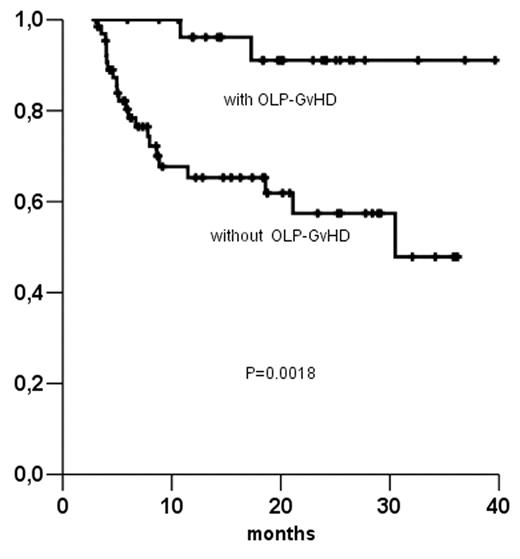Abstract
In reduced intensity allogeneic stem cell transplantation an increasing incidence of a lichen planus-like disorder of the oral cavity as manifestation of chronic graft versus host disease (cGvHD) has been reported, sometimes combined with a similar condition in the genital area. Oral lichen planus GVHD (OLP-GvHD) can occur as a single manifestation of cGvHD, without other organs affected. It resembles classic oral lichen planus both clinically and histologically. Clinical symptoms are a painful, burning sensation, diminished taste, loss of appetite and hyposalivation, sometimes resulting in problems with medication intake. Clinical examination is the main key in the diagnosis of OLP-GvHD. In some cases (modest) alterations of liver function can be detected as well. Apparently, no GvHD of the skin or digestive tract is present.
From January 2004 to March 2006, we performed a total of 96 RIST transplantations. All patients systematically underwent pretransplantation examination, including high quality photographs of the oral mucosa, by an oral medicine specialist. During follow up, 24 patients (25%) were diagnosed with OLP-GvHD without concomitant cGvHD of other organs. The diagnosis was based on clinical features, histopathology and by exclusion of any other causes (e.g. viral or yeast infections). Digital photographs of the oral lesions were compared with routinely taken pretransplantation photographs. Isolated OLP-GvHD (+/− modest liver function tests), was treated with topical dexamethasone elixer (0.11 mg/ml), if not successful (7/25 patients) also with tacrolimus ointment (0.1% + hypromellose 4000 mpa). After a median follow up of 12 months, a significant improvement of overall survival was seen in patients diagnosed with OLP-GvHD as compared with those with more extensive cGvHD or no cGvHD. The mean duration of local therapy of the oral cavity was 135 days and nearly all symptoms disappeared.
We conclude that after reduced intensity allogeneic stem cell transplantation the occurrence of OLP-GvHD predicts superior survival rates. Local treatment is sufficiently effective.
Disclosure: No relevant conflicts of interest to declare.
Author notes
Corresponding author


This feature is available to Subscribers Only
Sign In or Create an Account Close Modal